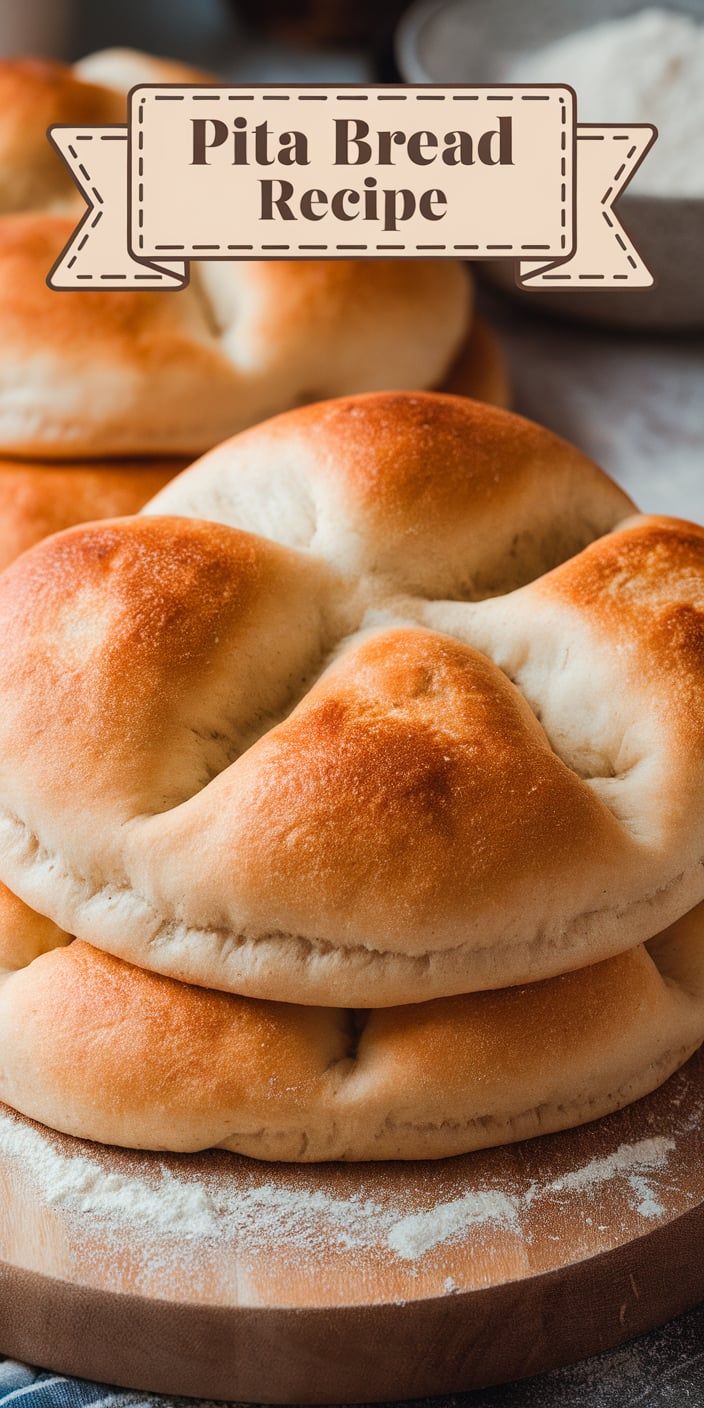It’s easy to make soft pita bread at home! I’ve found a simple recipe. It turns basic ingredients into warm, soft bread. This bread is perfect for any meal.
Making your own pita bread is more than just taste. It’s about the joy of baking. With a few ingredients and simple steps, you’ll make amazing pita bread. It will impress everyone.
This recipe is easy to follow. It’s great for beginners or experts. You’ll learn to make soft, authentic pita bread.
Get ready for a tasty baking journey. Your kitchen will smell amazing. You’ll make your own pita bread!

Why I Love Making Fresh Pita Bread at Home
My journey with pita bread started in my kitchen. It turned into a love for cooking. Making fresh pita connects me to old cooking ways and healthy foods.
My Personal Pita Making Story
My first try at homemade pita was a mess. My bread was flat and dense, not fluffy like I wanted. Practice makes perfect, and I learned to make real pita takes time and skill.
Incredible Health Benefits of Homemade Pita
Homemade pita is more than tasty. It’s also healthier than store-bought:
- Zero preservatives
- Less sodium
- Whole grains
- Fresher, better ingredients
Saving Money with Homemade Bread
Homemade pita is not only better for you, it’s cheaper too. Here’s how:
| Item | Store-Bought Cost | Homemade Cost |
|---|---|---|
| 4-6 Pita Breads | $3.99 | $0.75 |
| Monthly Savings | N/A | $38-$50 |
With a bit of time and effort, I save money. I get to enjoy healthy, fresh bread.
Essential Ingredients for Authentic Pita Bread Recipe
Making perfect homemade pita bread starts with good ingredients. I learned that keeping it simple is best. You only need a few things to make your kitchen smell like a Mediterranean bakery.
- All-purpose flour (4 cups) – the foundation of your pita dough
- Active dry yeast (2 1/4 teaspoons)
- Warm water (1 1/2 cups)
- Olive oil (2 tablespoons)
- Salt (1 teaspoon)
- Optional: Honey or sugar (1 teaspoon) to activate the yeast
Each ingredient is important for the perfect pita. Flour gives it structure, yeast makes air pockets, and olive oil adds richness. Using fresh, quality ingredients makes a big difference.
Pro tip: Using organic flour and extra virgin olive oil makes your pita better. Make sure your ingredients are at room temperature. This helps the dough mix well and rise nicely.
Kitchen Tools You’ll Need for Success
Getting ready to make real pita bread needs careful planning. The right tools make baking fun and easy. I’ll show you the must-have baking gear for perfect pitas.
Basic Equipment Requirements
- Large mixing bowl – Best if it’s ceramic or stainless steel
- Measuring cups and spoons
- Kitchen scale (for exact ingredient amounts)
- Sturdy wooden spoon or silicone spatula
- Clean kitchen towel
- Baking sheet or pizza stone
Optional Tools for Better Results
These tools are not needed but can make your pita better:
- Stand mixer with dough hook
- Dough scraper
- Pastry brush
- Infrared thermometer
- Proofing basket
Setting Up Your Workspace
Setting up your kitchen for pita bread needs some planning. Clear a big, clean counter with good light. Put all your tools and ingredients ready before you start. Make sure your dough has a warm, draft-free place to rise.
Pro tip: Arrange all ingredients and tools before you start. This way, making pita bread will be easy and fun.
Step-by-Step Mixing and Kneading Process
Learning to mix pita dough is like a special art. It turns simple things into tasty bread. I’ll show you how to make the best pita bread dough at home.
First, get these important ingredients ready:
- 4 cups all-purpose flour
- 2 teaspoons active dry yeast
- 1 teaspoon salt
- 1 1/4 cups warm water
- 2 tablespoons olive oil
Kneading pita bread needs patience and practice. Start with these key steps:
- Activate the yeast in warm water (about 110°F)
- Mix dry ingredients in a large bowl
- Create a well in the center and add liquid ingredients
- Combine until a shaggy dough forms
The key to great dough is consistent kneading. Knead the dough for 8-10 minutes by hand, or 5-6 minutes with a stand mixer. When it’s smooth and elastic, with a bit of shine, it’s ready.
Pro tip: Don’t hurry kneading. Good technique makes your pita bread perfect and it will rise well when baked.
The Secret to Perfect Pita Dough Rising
Learning how to make pita dough rise is key. It turns simple ingredients into a special treat. Knowing how to ferment dough makes your pita bread amazing.
Proofing pita bread needs patience and care. It’s not just waiting. It’s about making the right conditions for the dough to grow.
Temperature and Timing Guidelines
Temperature is very important for pita dough rising. Here are some tips:
- Ideal room temperature: 75-80°F (24-27°C)
- Minimum rising time: 1-2 hours
- Maximum rising time: 4-6 hours
Visual Cues for Perfectly Risen Dough
Knowing when your dough is ready is important. Look for these signs:
- Volume increase: Dough should double in size
- Surface becomes smooth and slightly puffy
- Gentle press leaves a slight indentation
Troubleshooting Common Rising Issues
| Problem | Possible Cause | Solution |
|---|---|---|
| Dough not rising | Old yeast or cold temperature | Use fresh yeast, warm environment |
| Dough rising too quickly | Overly warm environment | Move to cooler location |
| Dense texture | Insufficient rising time | Allow more time for fermentation |
Pita dough rising is like an art. It takes practice. Each try teaches you something new. Trust your instincts, watch closely, and enjoy the journey!
Shaping and Rolling Your Pita Bread
Making real pita bread means you must learn to shape the dough right. I’ll show you how to make perfect pita bread every time.
First, split your dough into equal parts. Use a kitchen scale for the best results. A 3-ounce piece is perfect for regular-sized pitas.
- Gently shape each piece into a smooth ball
- Cover the dough balls with a damp cloth to prevent drying
- Let the balls rest for 10 minutes to relax the gluten
Rolling pita bread needs care. I use a wooden rolling pin on a floured surface. Keep the dough about 1/8 inch thick. If it’s too thick or too thin, it won’t turn out right.
| Technique | Key Details |
|---|---|
| Rolling Direction | Roll from center outward in all directions |
| Thickness Check | Aim for uniformity, about 1/8 inch thick |
| Resting Time | Let rolled dough rest 5 minutes before baking |
Pro tip: Turn the dough a bit after each roll. This helps it become round. With practice, you’ll get the hang of it.
Baking Techniques for Perfectly Puffed Pitas
Learning to bake pita bread is all about being precise. It’s about knowing the right techniques. The secret to perfectly puffed pitas is controlling the oven temperature and creating the perfect baking environment.
Oven Temperature Essentials
The oven temperature is key for that perfect puff. I suggest preheating to 475-500°F (246-260°C). This high heat makes the steam pocket that makes pitas rise.
- Preheat baking stone or heavy baking sheet for 30 minutes
- Use middle rack for most consistent heat distribution
- Avoid opening oven door during initial baking stage
Creating the Perfect Steam Pocket
The secret to puffed pitas is quick heat change. Moisture in the dough turns to steam. This creates the bubble that makes pitas puff up. Important factors include:
- Ensure dough is rolled thin and evenly
- Use minimal flour when rolling
- Place pita directly on hot surface
Timing Your Bake
Baking time is usually 3-4 minutes. Look for these signs:
| Baking Stage | Visual Indicator |
|---|---|
| Initial Puffing | Slight balloon-like expansion |
| Perfect Bake | Golden brown spots, fully inflated |
| Overdone | Dark brown or black edges |
Storage Tips and Reheating Methods
Storing pita bread right keeps it tasty and soft. Cool your pitas at room temperature after baking. This stops them from getting soggy.
For a few days, store them in a sealed bag or airtight container. A hot skillet or oven reheats them well. Just 30 seconds makes them soft again.
Freezing is great for keeping pita bread fresh longer. Wrap each pita in parchment paper, then in a freezer bag. They last up to three months. Thaw and warm them up to enjoy.
Pro tip: Stale pitas can still be used. Make crispy chips or a quick pizza base. A bit of olive oil and toasting can make them new again.
